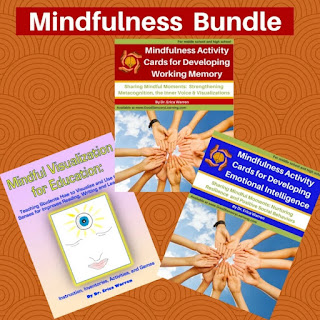This week I wanted to tell you about my online store, Good Sensory Learning. I’m Dr. Erica Warren, and I established this site so I could share all the materials that I have created over the last 20+ years as a learning specialist and educational therapist. When I first began my private practice, Learning to Learn, I had great difficulty finding fun and multisensory materials for my students that were effective and engaging. So back in 2005, I made it my mission to design and distribute high-end, remedial products as well as memorable, motivating lessons that bring delight to learning. If you would like to try a free sampling of my activities , CLICK HERE . How Are the Products Organized at Good Sensory Learning? You can download my Free Printable Catalog or you can browse the site using the grey “search all products” bar in the top right of any page with keywords such as dyslexia, working memory, and executive functioning. What’s more, drop down menus in the red banner allow you t...
What is a Fixed and Growth Mindset?
In a fixed mindset, students believe that their abilities are dependent on fixed traits that can not be changed such as intellect or talent. Individuals that think this way, often cultivate a self-defeating identity, feel powerless, and many struggle with a sense of learned helplessness. In contrast, students with a growth mindset accept that abilities and aptitude can be developed with persistence and effort. As a result, these individuals are not intimidate by failure, because they realize that mistakes are a part of the learning process. They continue working hard despite any difficulties or setbacks.
So What Can Teachers do to Nurture a Growth Mindset in the Classroom?
- Instruct your students about what it is to have a growth mindset and ask them to interview and write about someone that has a growth mindset.
- Resist offering hints when students struggle to answer questions. Instead, allow your students the time to think aloud and formulate answers so that they can embrace this as part of the learning process.
- Demonstrate your own growth mindset by seeing yourself as a lifelong learner that can improve and grow.
- Teach your students that what is most important is what they do after a failure. Ask them to discuss this in small groups and then share their conclusions with the class.
- Create an environment that nurtures and rewards students that maintain motivation and effort. Provide opportunities for students to learn from their mistakes, make corrections and improve grades.
- Share real-life stories of past and present students that have exhibited a growth mindset. Challenge your students to do the same.
- Read about successful people who worked hard, struggled, and overcame obstacles to reach a high level of achievement. Ask your students to write about how they could apply a similar mindset to their own life.
- Recognize initiative and praise students for hard work. Avoid accolades for intelligence or talents. To learn more about this, watch this video by Trevor Regan at Train Ugly.
- Encourage students to be aware of their inner voice and to speak to themselves like they would speak to their best friend. Help them to become aware of any fixed mindset phrases they may use such as "I can't do this." Ask your students to share other fixed mindset phrases they have used in the past and make a list on the board. Next, as a group, reword all the fixed mindset phrases listed with growth mindset suggestions. For example, a growth mindset phrase might say, "This may be difficult at first, but with practice and effort I can master this!"
- Watch this video by Trevor Regan at Train Ugly and lead a discussion with your students about how they can become better learners.
- Celebrate mistakes and thank students for sharing any misconceptions. Tell your students that this will help you to be a better teacher, and they will become resilient learners.
- Offer a suggestion box to your students, so that they can share thoughts and ideas that can help to improve the classroom environment, instruction methods, and assessment tools.
- Find out what motivates your students and integrate it into the curriculum. Then, share your own enthusiasm and excitement on the topic.
- Don't give homework. Instead, assign creative, home-fun activities that are optional. Provide assignment possibilities that students will enjoy completing and let them be a part of creating these assignment options.
- Watch Angela Duckworth's TED video and lead a discussion about how students can become more gritty.

If you have any more suggestions on what we can do to nurture a growth mindset in the classroom, please make a comment below this blog post.
Cheers, Erica
Dr. Erica Warren is the author, illustrator and publisher of multisensory educational materials at Good Sensory Learning and Dyslexia Materials. She is also the director of Learning to Learn and Go Dyslexia, in Ossining, NY. To learn more about her products and services, you can go to https://godyslexia.com/, www.goodsensorylearning.com, www.dyslexiamaterials.com & www.learningtolearn.biz Cheers, Erica
· Blog: https://learningspecialistmaterials.blogspot.com/
· YouTube Channel: https://www.youtube.com/user/warrenerica1
· Podcast: https://godyslexia.com/
· Store: http://www.Goodsensorylearning.com/ & www.dyslexiamaterials.com
· Courses: http://www.learningspecialistcourses.com/
· Newsletter Sign-up: https://app.convertkit.com/landing_pages/69400



Comments
Post a Comment